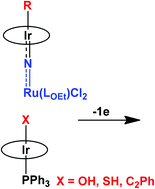Iridium porphyrin complexes with μ-nitrido, hydroxo, hydrosulfido and alkynyl ligands†
Abstract
Iridium porphyrin complexes containing μ-nitrido, hydroxo, hydrosulfido, and alkynyl ligands have been synthesized and structurally characterized, and their oxidation has been studied. The alkyl-IrIII porphyrin complex [Ir(tpp)R] (tpp2− = 5,10,15,20-tetraphenylporphyrin dianion; R = C8H13; 1) was synthesized by reaction of [Ir(cod)Cl]2 (cod = 1,5-cyclooctadiene) with H2tpp in refluxing monoethylene glycol. Treatment of 1 with PPh3 and [(LOEt)Ru(N)Cl2] (LOEt− = [(η5-C5H5)Co{P(O)(OEt)2}3]−) gave [Ir(tpp)(R)(PPh3)] (2) and the μ-nitrido complex [R(tpp)Ir(μ-N)RuCl2(LOEt)] (3), respectively. The cyclic voltammogram of 3 exhibited a reversible oxidation couple at 0.44 V versus Fc+/0 (Fc = ferrocene). The oxidation of 3 with [(4-BrC6H4)3N](SbCl6) resulted in Ir–C bond homolysis and formation of the chloride complex [Cl(tpp)Ir(μ-N)RuCl2(LOEt)] (4). The short Ir–N(nitrido) bond distances in 3 [1.944(3) Å] and 4 [1.831(4) Å] are indicative of multiple bond character and thus these two μ-nitrido complexes can be described by the two resonance forms: IrIII–N![[triple bond, length as m-dash]](https://www.rsc.org/images/entities/char_e002.gif) RuVI and IrV
RuVI and IrV![[double bond, length as m-dash]](https://www.rsc.org/images/entities/char_e001.gif) N
N![[double bond, length as m-dash]](https://www.rsc.org/images/entities/char_e001.gif) RuIV. Similarly, the oxidation of 2 with [(4-BrC6H4)3N](SbCl6) yielded [Ir(tpp)Cl(PPh3)] (5). Chloride abstraction of 5 with TlPF6 in tetrahydrofuran (thf) afforded [Ir(tpp)(PPh3)(thf)](PF6) (6) that reacted with CsOH·H2O and Li2S to give the hydroxo [Ir(tpp)(OH)(PPh3)] (7) and hydrosulfido [Ir(tpp)(PPh3)(SH)] (8) complexes, respectively. Treatment of 6 with phenylacetylene in the presence of CuI and Et3N yielded the bimetallic complex [Ir(tpp)(PPh3)(μ-η1:η2-C
RuIV. Similarly, the oxidation of 2 with [(4-BrC6H4)3N](SbCl6) yielded [Ir(tpp)Cl(PPh3)] (5). Chloride abstraction of 5 with TlPF6 in tetrahydrofuran (thf) afforded [Ir(tpp)(PPh3)(thf)](PF6) (6) that reacted with CsOH·H2O and Li2S to give the hydroxo [Ir(tpp)(OH)(PPh3)] (7) and hydrosulfido [Ir(tpp)(PPh3)(SH)] (8) complexes, respectively. Treatment of 6 with phenylacetylene in the presence of CuI and Et3N yielded the bimetallic complex [Ir(tpp)(PPh3)(μ-η1:η2-C![[triple bond, length as m-dash]](https://www.rsc.org/images/entities/char_e002.gif) CPh)(CuI)] (9), whereas the transmetallation of 6 with LiC
CPh)(CuI)] (9), whereas the transmetallation of 6 with LiC![[triple bond, length as m-dash]](https://www.rsc.org/images/entities/char_e002.gif) CPh afforded the mononuclear alkynyl complex [Ir(tpp)(PPh3)(C
CPh afforded the mononuclear alkynyl complex [Ir(tpp)(PPh3)(C![[triple bond, length as m-dash]](https://www.rsc.org/images/entities/char_e002.gif) CPh)] (10). The electrochemistry of the Ir porphyrin complexes has been studied using cyclic voltammetry. On the basis of the measured redox potentials of [Ir(tpp)(PPh3)X], the ability of X− to stabilize the IrIV state is ranked in the order: R− > PhC
CPh)] (10). The electrochemistry of the Ir porphyrin complexes has been studied using cyclic voltammetry. On the basis of the measured redox potentials of [Ir(tpp)(PPh3)X], the ability of X− to stabilize the IrIV state is ranked in the order: R− > PhC![[triple bond, length as m-dash]](https://www.rsc.org/images/entities/char_e002.gif) C− > Cl− ∼ OH−. Oxidation of 8 and 9 with [(4-BrC6H4)3N](SbCl6) led to isolation of 5 and [Ir(tpp)(PPh3)(H2O)]+, respectively. The crystal structures of complexes 3, 4, and 7–10 have been determined.
C− > Cl− ∼ OH−. Oxidation of 8 and 9 with [(4-BrC6H4)3N](SbCl6) led to isolation of 5 and [Ir(tpp)(PPh3)(H2O)]+, respectively. The crystal structures of complexes 3, 4, and 7–10 have been determined.



 Please wait while we load your content...
Please wait while we load your content...